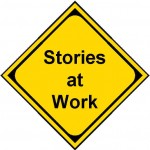We live by stories
In reading a fascinating profile of brain researcher Dr. Michael Gazzaniga, I came across this:
across this:
The left hemisphere takes what information it has and delivers a coherent tale to conscious awareness. It happens continually in daily life, and most everyone has caught himself or herself in the act — overhearing a fragment of gossip, for instance, and filling in the blanks with assumptions.
The brain’s cacophony of competing voices feels coherent because some module or network somewhere in the left hemisphere is providing a running narration…. We narrate our lives, shading every last detail, and even changing the script retrospectively, depending on the event, most of the time subconsciously. The storyteller never stops, except perhaps during deep sleep.
In other words, story is how our brains organize the vast amount of information coming to us in each moment – as well as the competing ways various parts of our brains interpret what we perceive. Apparently, we need stories just to exist as conscious beings.
So it stands to reason that story is a powerful tool for learning, for adults as well as kids.
We’ve found that having Interactors demonstrate specific workplace situations (say, a manager having to deliver bad news to her team) allows learners to share a common story. They can talk about the situation we’ve presented, rather than reveal their own struggles at work. And each learner can fill in the story line with his own experiences, so he takes away useful ideas and behavior to try out back on the job.
Of course, we’ve found that practice is crucial for actually applying new learning, and creating effective practice is our mission. And the most powerful way to practice is within a strong story.
People sitting in a classroom are already telling themselves stories about what they’re experiencing. Why not harness that power to further the learning?
Postscript: Here’s comics great John Ostrander on how everything is story.
